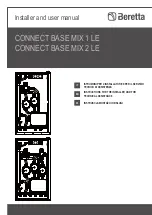
Supplied By www.heating spares.co Tel. 0161 620 6677
8
FAULT FINDING
GENERAL
8.1
Before looking for a fault condition, check that:
●
The mains electrical supply is turned on.
●
The clock, room or cylinder/tank thermostat (where fitted) are
calling for heat.
●
The gas service cock is open.
●
The CH and DHW isolation cocks are open.
●
The system is at design pressure.
Before attempting any electrical fault finding, always conduct the
preliminary electrical system checks as described in the Instructions
for the British Gas Multimeter, or other similar instrument.
On completion of any service or fault finding operation involving making
or breaking electrical connections, always check for EARTH
CONTINUITY, POLARITY and RESISTANCE TO EARTH.
Detailed procedures for replacing faulty components are described in
section 9 (Parts Replacement).
DIAGNOSTIC LED INDICATORS
8.2
FASCIA PANEL, Figure 30
The
Reset
LED shows steady RED in a lockout condition and the error
code will be displayed by the 4 yellow lights above the two control knobs.
For fault finding, refer to the diagnostic chart shown below, together
with the notes given in sections 8.3, 8.4 and 8.5.
Depending on the fault condition, the boiler can be reset by pressing the
RED
Reset
light.
DOMESTIC HOT WATER FAULT
FINDING (CBX APPLIANCES ONLY)
8.4
When the hot water tap is turned on, the control should perform a series
of checks followed by an ignition sequence. Refer to section 5.2.
If the control has powered up correctly but does not respond to a DHW
demand, check the following:
a)
Check that the DHW flow rate at the tap is greater than 2.5
litre/minute.
b)
Check the operation of the DHW flow turbine, Figure 28.
c)
Check the wires to the DHW flow turbine.
d)
Check connector X8 is correctly connected to the PCB.
If the above items are ok, replace the PCB.
If DHW temperature fluctuates heavily during a long draw off, check the
secondary plate heat exchanger filter for debris, clean and replace,
(refer to section 9.19).
CENTRAL HEATING FAULT FINDING
8.5
Upon a demand for Central Heating, (closure of the time switch and room
thermostat, where fitted), the controls should carry out a set of start up
checks, followed by an ignition sequence. Refer to Section 5.2.
If the control has powered up correctly but does not respond to a CH
demand. Check voltage between pin 2 connector X1A (orange wire) and
pin 2 connector X1B (blue wire). If 0 V ac, check room thermostat and
clock. If 230 V ac, check control for lockout or blocking codes, (refer to
section 8.3), check operation of the pump.
Note:
Whenever a CH demand is removed, either by the timer, the room
thermostat or by the appliance's internal temperature control, an anti
cycle mode is initiated which prevents the appliance from firing in CH
mode for 5 minutes. Ensure that the control is not in this mode by
removing power from the control and restoring it after a delay of 10
seconds.
If room thermostat and clock are OK and no lockout or blocking code
exists and the control is not in anti cycle mode, then replace PCB.
FAULT FINDING CODES
8.3
In the event of the appliance failing to light, refer to the Diagnostics
Chart.
For further information contact: Halstead Boilers Ltd. Service Help line:
0844 371 1111.
FASCIA PANEL
30
LED 1
LED 2
LED 3
LED 4
CLOCK
PRESSURE
GAUGE
DHW TEMP
CONTROL
CH TEMP
CONTROL
ON/OFF
SWITCH
RESET & burner/
lock-out LED
30
751030 MANUAL (NEW) 21/9/10 08:42 Page 32
















































